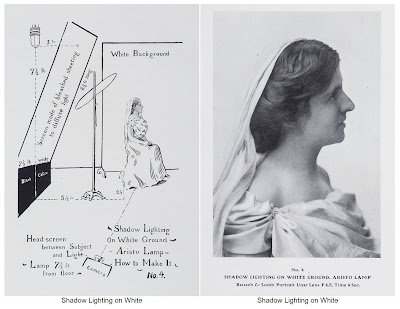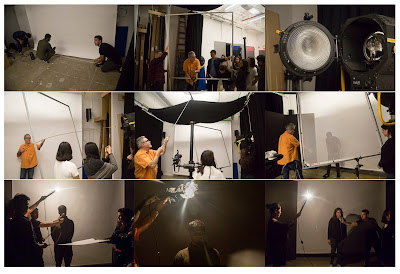Wednesday, September 30, 2015
Wednesday, September 23, 2015
Assignment 3 One Light
Using the 250 watt halogen bulb in the equipment closet, make a portrait by selecting a quality and direction of light to communicate an emotion that you feel about a person. Make an additional portrait that reflects the opposite feeling you have about the person. Explain in writing the laws of light that were at work in each portrait.
Lesson 3 Direction of Light, Diffusion, Refraction,and Using One Light
Wednesday, September 16, 2015
Assignment 2 Demonstrate the 3 Laws of Light in One Photograph
In one photograph using one light source clearly demonstrate the 3 laws of light at work. Include the light source in the photograph. The subject is the light. Think of it as more of a physics project than a photograph. Use a dodging tool to prevent the light from flaring the lens. Try to crop out any rigging you might use and make the image about the light.
Lesson 2 Angle of Incidence Equal Angle of Reflection
Monday, September 7, 2015
Assignment 1 Inverse Square Law
1. Using 3 identical 4x5 grey cards set 1 foot apart, overlapping slightly and placed at a 45 degree angle from the camera angle. Make 4 photographs of the cards with the light 2 feet, 4 feet, 8 feet, and 16 feet from the middle card. Use an incident meter on the middle card to give the correct exposure. The middle card should have the same value on each photograph. Use Lightroom to weak the middle card until they all read the same value.
2. Use 3 4x5 cards a black card in front, a grey card in the middle and a white card in the back. Using the same single point source make all 3 cards appear to be the same value. You can move the cards and the light source until it works.
3. Create a blog on blogger using your google account and use the simple template.
4. Send the url for your blog to ccs@nyc.rr.com by next Monday.
Lesson 1 Inverse Square Law
The inverse square law states that the intensity of the light from a point source diminishes inversely to the square of the distance. I=1/d² Here is a better illustration that what I drew on the white board.
Here is a diagram of the 1st part of the assignment.
Example of how part 1 of the assignment should be laid out.
The top picture is an example of how you can lay out part 2 of the assignment.
Production Stills
I got this next chart from Lee Varis's website. He illustrates here the relationship of 18% grey to a modified 10 step zone system, 50% that you would see in Lightroom's histogram and the number 118 you see in Photoshop's histogram using RGB color space.
Here is the results of our test in class with the middle grey card adjusted in Lightroom and tweaked in photoshop to look the same. You can see the Front card gets darker in relation to the Middle card as the light is moved further away and the Back card gets lighter as the light is moved further away.
Syllabus
Instructor:
Chris Callis
ccallis@sva.edu
PHG-5411-C (75302) STUDIO
The
Laws of Light and How to Break Them
Fall
2015, Wednesday 10:00am-12:50pm
Location:
SVA MFA Photo Studio
Who should take this
class:
Anyone
interested in learning photographic lighting.
No prior knowledge of lighting is required.
Class Description:
This
course is an opportunity to learn the laws of light and to gain an appreciation
of how important an understanding of light is to a photographer’s process. The
class will begin with an exploration of the physics of light in order to
explain its behavior. The weekly sessions and assignments will teach the
student how to approach every lighting experience with confidence. The purpose is to master these concepts and
to ensure effective application of this knowledge. The ability to problem solve
is a crucial element when faced with challenging lighting situations and
without this understanding it is very difficult to move beyond obvious
limitations. The ultimate goal is to be able to apply these concepts and then
to see all the possibilities.
Assignments:
Each
week there will be a demonstration and a class exercise that will end with a
weekly assignment. There will be a total of thirteen weekly assignments and one
final project.
Each
student will post their weekly assignments on their lighting blog along with a
sketch and brief explanation of their results.
Grading:
A
commitment from the students is expected. Being on time, prepared with homework
and ready to learn are requirements. Active
participation during the demonstrations is also required. The student’s aesthetic approach to lighting along
with the blog presentation are factors in grading.
Schedule:
9/9 Lesson
1: Intros, ID photos, Blog, Lightroom demo, Inverse
Square Law
9/16 Lesson
2: Angle of Incidence, Light Travels in a
Straight Line
9/23 Lesson
3: One Light Source - Direction of Light,
Diffusion/Diffraction
9/30 Lesson
4: Simulated Window Light
10/7 Lesson
5:
10/14
Lesson 6: Size
Matters
10/21
Lesson 7: Color
of Light - Strobe & Continuous, Gels, Balancing Light
10/28
Lesson 8: Dedicated Flash
11/4 Lesson
9:
11/11
Lesson 10: Speedlight System
11/18
Lesson 11: Specular Reflection - Cross-polarization,
Still Life of Shiny Metal and Glass
11/25
Lesson 12: Night Photography
12/2 Lesson 13:
12/9 Lesson 14: Bring in a lighting problem to solve
12/16 Lesson
15: Review final assignment
Subscribe to:
Comments (Atom)




































